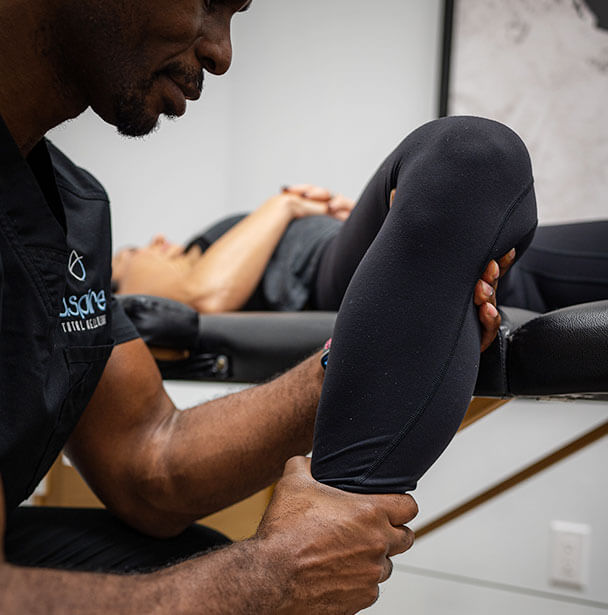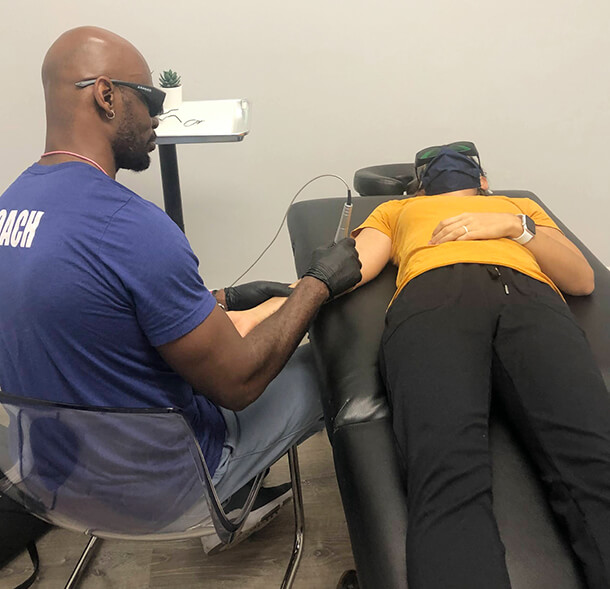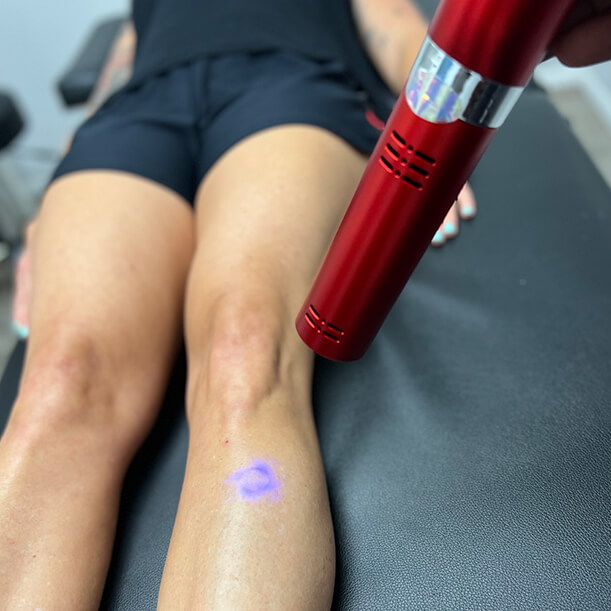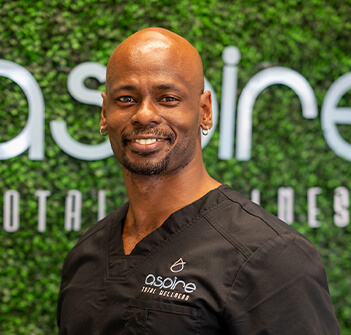Kinesiology
Our muscles can tell us so much about our bodies. This is at the heart of kinesiology – the study of our bodies’ mechanics through the lens of our muscles, joints, ligaments and tendons. Our kinesiologist is trained in identifying the links between them with the goal of helping you strengthen and heal your body. Our kinesiologist will use a variety of the treatments described in this page to address your particular needs in your body work session.
Mobility Training
Mobility Training is an effective way to increase your body’s full range of motion. This inter-disciplinary approach works to eliminate chronic pain and restore flexibility through gentle resistance exercises.
A common misconception is that mobility and flexibility are synonyms. They are not! Flexibility training is simply the passive stretching of the muscles. On the other hand mobility training focuses on your joints to improve your body’s full range of motion through active resistance. The result is less pain, better posture, and so much more.
During Mobility Training you can expect the following:
- Movement assessment to identify dysfunction.
- Develop custom protocol for the patient with a variety of banded modality and body weight modality movements.
- A typical session will contain a variety of movements based on the prescribed protocol.
- A typical session lasts between 45 to 60 minutes.
- Typically a patient will have weekly or by-weekly check-ups in person or by phone to measure progress.
Mobility training can help with the following conditions among others:
- Range of motion
- Posture
- Muscle ligament tendon joint strength
- Sciatic pain
- Shoulder pain
- Foot Pain
- Lumbar disc herniation
- Cervical spondylosis
- Carpal Tunnel Syndrome

Mobility training can help with the following conditions among others:
- Range of motion
- Posture
- Muscle ligament tendon joint strength
- Sciatic pain
- Shoulder pain
- Foot Pain
- Lumbar disc herniation
- Cervical spondylosis
- Carpal Tunnel Syndrome
Cupping

Cupping
Cupping increases blood circulation to the area where the cups are placed. This may relieve muscle tension, which can improve overall blood flow and promote cell repair. It may also help form new connective tissues and create new blood vessels in the tissue.
During a cupping treatment, you can expect the following:
- Your practitioner will ask you what symptoms you’ve been experiencing, likely taking a detailed health history if this is your first time visiting them.
- The practitioner will place cups on your skin.
- You’ll feel a sucking sensation and pressure as the cups are suctioned.
- The practitioner may use heat or suction alone to place the cups.
- Depending on the type of cupping, the practitioner may leave you to rest for a few minutes before they return to remove the cups.
- Your skin may turn red and show light bruising after your session.
- Any discoloration or marks from cupping usually go away within 7 days of the session.
Cupping therapy can help with the following conditions, among others:
- lower back pain
- shingles
- lumbar disc herniation
- diabetes mellitus
- neck & shoulder pain
- facial paralysis
- cervical spondylosis
- rheumatoid arthritis
- headache & migraine
- cough and dyspnea
- carpal tunnel syndrome
- asthma
- knee pain
- acne
- hypertension
- brachialgia
Myofascial Release
Myofascial release is an alternative medicine therapy useful for treating skeletal muscle immobility and pain by relaxing contracted muscles, improving blood and lymphatic circulation, and stimulating the stretch reflex in muscles. It also loosens scar tissue and superficial fascia.
During Myofascial Release you can expect the following:
- Manual pressure will be used to manipulate the fascia.
- Alternatively a scraping tool may be used.
- This releases the tension in the fascia to increase circulation and range of motion in the area
- A session typically lasts 30 minutes.
Myofasial Release can help with the following conditions:
- Shoulder pain
- Blood flow
- Lymphatic circulation
- Increase muscle and joint range of motion to decrease pain

Blue Light Therapy/Red Light Therapy
Infrared and Terahertz Light Therapy has an established history of skin uses. The U.S. Navy SEALs began using it in the 1990s to help heal wounds quickly and to help regenerate damaged muscle tissues.
Since then, the treatment has been researched for different situations in aesthetics. It’s mainly noted for increasing collagen in tissues, which can smooth out your skin and reduce the appearance of damage from age spots, acne and wrinkles.
There are different frequencies, or wavelengths, used with infrared light treatment. These include red and blue light frequencies, which don’t contain ultraviolet rays and are readily absorbed into the skin.
Red Light Therapy
Red, or infrared, light is used for treating the epidermis, which is the outer layer of skin. When the light is applied to your skin, the epidermis absorbs it and then stimulates collagen proteins.
In theory, more collagen means that your skin will look smoother and fuller, which can reduce the appearance of fine lines and wrinkles. Red light is also thought to reduce inflammation while improving circulation, which can give you a healthier glow. Red Light Therapy promotes Angiogenesis, which happens when blood flow increases and new blood pathways are developed which speeds up healing.
Red light therapy is used to treat:
- acne
- decrease scarring
- promote anti-inflammatory effects
- Loosen up tight muscles
- Break up knots in your muscles (adhesions)

During Red Light Therapy you can expect the following:
- A typical light therapy session lasts 5 to 15 minutes.
- If you’re sensitive to heat, blue light therapy can be provided without it.
- You may feel a warming or tingling sensation during treatment.
- Skin will be flushed, have a red coloration and may be warm to touch for a short time after treatment.
Blue Light Therapy
Blue light therapy, on the other hand, targets the sebaceous glands, which are also called oil glands. They’re located beneath your hair follicles. Sebaceous glands are necessary for lubricating your skin and hair so that it doesn’t dry out. However, these glands can become overactive, leading to oily skin and acne.
Blue light therapy can target these oil glands and make them less active. In turn, you may see fewer acne breakouts. Blue light can also kill acne-causing bacteria beneath the skin, which can help treat severe acne pimples, including cysts and nodules. Blue Light Therapy promotes endocytosis which increases the cells ability to absorb water by up to 50% and speeds up healing.
Blue Light therapy light is used to treat:
- acne
- decrease scarring
- promote anti-inflammatory effects
- Loosen up tight muscles
- Break up knots in your muscles (adhesions)

During Blue Light Therapy you can expect the following:
- A typical light therapy session lasts 5 to 15 minutes.
- If you’re sensitive to heat, blue light therapy can be provided without it.
- You may feel a warming or tingling sensation during treatment.
- Skin will be flushed, have a blue coloration and may be warm to touch for a short time after treatment.
Class IV Laser Therapy
Relieves Muscle soreness, pain, pre/post surgery, arthritis, injuries. FDA approved Class IV Laser Therapy accelerates recovery and the healing process, reduces inflammation and aids in the treatment of opioid free chronic and acute pain. Learn More

Meet Jeff Mumford, our in-house Mobility Specialist
His own struggle with injury on duty sparked his interest in mobility training.
Through studying anatomy, physiology, and kinesiology, Jeff developed a keen eye for assessing pain and muscle weakness.
His personalized approach to mobility training has helped many Aspire Total Wellness clients reduce chronic pain and return to living their lives to the fullest.